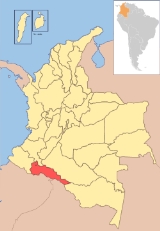
Putumayo Department
Encyclopedia
Putumayo is a department
of Colombia
. It is in the south-west of the country, bordering Ecuador
and Peru
. Its capital is Mocoa
.
The word putumayo comes from the Quechua
language. The verb putuy means "to spring forth" or "to burst out", and mayo is a variant of mayu, meaning river. Thus it means "gushing river".
The current territory of Putumayo was linked to Popayan during the Spanish Colony and on the firsts Republican decades belonged to the huge "Department of Asuay, that included territories in Ecuador and Perú. Later starts a ling process of territorial redistributions:
A dark chapter in the history of Putumayo was the rubber fever
, from the late 19th century until the 20th century. During this period, the Casa Arana enslaved and killed thousands of natives from Amazonia, these were used to extract natural rubber. Nowadays, however, a few native communities exist that withstood the Spanish colonization, the rubber exploitation, the recent oil extraction and the modern colonization.
Departments of Colombia
Colombia is an unitary republic formed by thirty-two departments and a Capital District . Each department has a Governor and a Department Assembly , elected by popular vote for a four-year period. The governor cannot be re-elected in consecutive periods...
of Colombia
Colombia
Colombia, officially the Republic of Colombia , is a unitary constitutional republic comprising thirty-two departments. The country is located in northwestern South America, bordered to the east by Venezuela and Brazil; to the south by Ecuador and Peru; to the north by the Caribbean Sea; to the...
. It is in the south-west of the country, bordering Ecuador
Ecuador
Ecuador , officially the Republic of Ecuador is a representative democratic republic in South America, bordered by Colombia on the north, Peru on the east and south, and by the Pacific Ocean to the west. It is one of only two countries in South America, along with Chile, that do not have a border...
and Peru
Peru
Peru , officially the Republic of Peru , is a country in western South America. It is bordered on the north by Ecuador and Colombia, on the east by Brazil, on the southeast by Bolivia, on the south by Chile, and on the west by the Pacific Ocean....
. Its capital is Mocoa
Mocoa
Mocoa is a municipality and capital city of the department of Putumayo in Colombia.The city is located in the northwest of the Putumayo department. The municipality borders the departments of Nariño to the west and Cauca to the north.-External links:...
.
The word putumayo comes from the Quechua
Quechua languages
Quechua is a Native South American language family and dialect cluster spoken primarily in the Andes of South America, derived from an original common ancestor language, Proto-Quechua. It is the most widely spoken language family of the indigenous peoples of the Americas, with a total of probably...
language. The verb putuy means "to spring forth" or "to burst out", and mayo is a variant of mayu, meaning river. Thus it means "gushing river".
History
Originally, the south west of the department was territory of the Cofán Indians, the north west of the Kamentxá Indians, and the center and south belong to tribes that spoke Tukano languages (such as the Siona), and the east to tribes that spoke Witoto languages. Part of the Kamentxá territory was conquered by the Inca Huayna Cápac in 1492, who after crossing the Cofán territory, established a Quechua population on the valley of Sibundoy, that is known today as Ingas. After the Inca defeat in 1533, the region was invaded by the Spanish in 1542 and since 1547 administered by catholic missions.The current territory of Putumayo was linked to Popayan during the Spanish Colony and on the firsts Republican decades belonged to the huge "Department of Asuay, that included territories in Ecuador and Perú. Later starts a ling process of territorial redistributions:
- 1831: Province of PopayánPopayánPopayán is the capital of the Colombian department of Cauca. It is located in southwestern Colombia between Colombia's Western Mountain Range and Central Mountain Range...
. - 1857: Estado Federal del Cauca.
- 1886: Departament of CaucaCauca DepartmentCauca is a Department of Colombia. Located in the south-western part of the country, facing the Pacific Ocean to the west, the Valle del Cauca Department to the north, Tolima Department to the northeast, Huila Department to the east and the Nariño Department to the south, covering a total area of...
. - 1905: Intendencia del Putumayo.
- 1909: Intendencia del CaquetáCaquetáCaquetá may refer to:* Caquetá River, a river in Colombia* Caquetá Territory, a former territory of Colombia* Caquetá Department, a department of Colombia...
. - 1912: Comisaría Especial del Putumayo.
- 1953: Departament of Nariño.
- 1957: Comisaría Especial del Putumayo.
- 1968: Intendencia Especial del Putumayo.
- 1991: Departament of Putumayo.
A dark chapter in the history of Putumayo was the rubber fever
Rubber boom
The rubber boom was an important part of the economic and social history of Brazil and Amazonian regions of neighboring countries, being related with the extraction and commercialization of rubber...
, from the late 19th century until the 20th century. During this period, the Casa Arana enslaved and killed thousands of natives from Amazonia, these were used to extract natural rubber. Nowadays, however, a few native communities exist that withstood the Spanish colonization, the rubber exploitation, the recent oil extraction and the modern colonization.

